Bass compressor pedals represent a popular type of effect pedals to process the sound of musical power instruments. If you want to choose the best bass compressor pedal – keep reading this article.
You may ask – how do sound effect pedals work? Well, some of them change the intensity completely, while others only add volume and make it deeper. Some models are oversized and used only in studios, while others are compact – allowing them to be transported for use at concerts, rehearsals, and generally anywhere.
The next question is – why are the pedals needed if the guitar is already playing? The first such appliances appeared in the sixties of the last century and quickly gained popularity among musicians. And now it’s hard to imagine that playing the electric guitar would do without them. Because without pedals, the instrument sounds like the most ordinary acoustics, and electro is taken in to make rock with hard, core, and other prefixes.
Compression itself defines the process of changing the dynamics of sound, leveling its volume, making a loud sound quieter. A compressor is essentially an automatic volume control. With the help of a compressor pedal, you can level off the sound, or rather catch the very balance between quiet and loud, and make it perfect. And finally, all the solos will sound without failures, the distortion will ignite in full force and there will be many more good changes. But be sure that the correct place in the chain is selected for this pedal and the correct tuning is made
If you need perfect quality and price ratio, then pay attention to the section with the cost of under 200$ of these bass compressor pedal reviews.
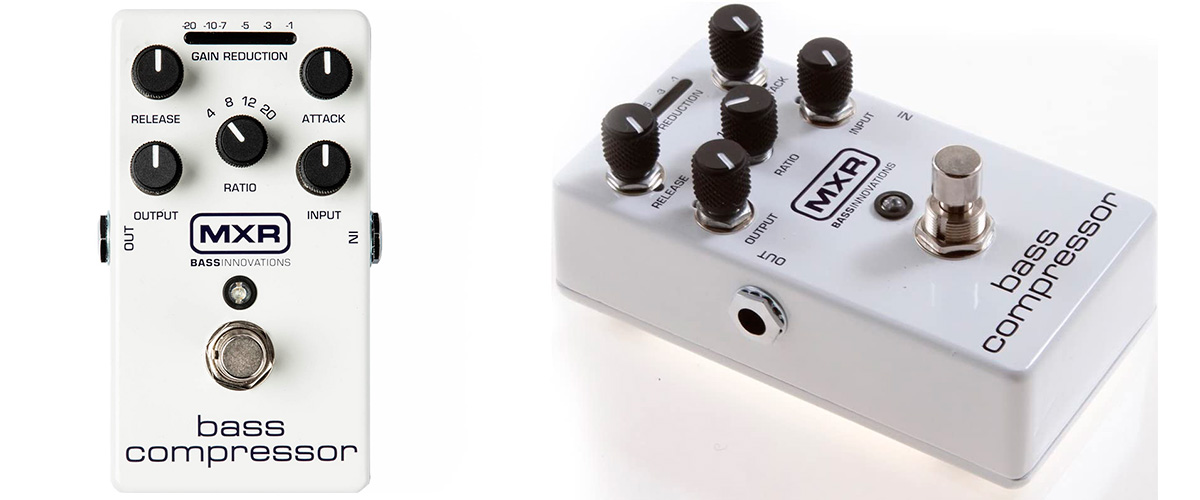
Best Bass Compressor Pedal Reviews
Best Bass Compressor Pedal Under $200
MXR M87 – best overall

Dunlop MXR M87 Bass Compressor is an impressive device with a wide range of settings – “Attack”, “Release”, “Ratio”, “Input” and “Output” – allows you to fine-tune the effect, from a slight limitation of peaks to hard “spot” compression.
CHT (Constant Headroom Technology) allows you to achieve a large margin for preamplification and ensure a clear sound. This transparent sound compressor allows you to embody the full dynamic range of your instrument, and when the compressor threshold is reached, the compression level will be displayed on the front panel of the pedal with ten bright LCD diodes.
This pedal also features all of the necessary controls(Output, Input, Ratio, Attack, Release, and Enter), and one 1/4 ” jack input and output. It has a 9 V battery which requires a 9 V adapter that can be bought separately. The other characteristics include resistance to the input of 1 MOhм and the output of 600 Ohms.
I should admit that the MXR M87 Bass Compressor works great – with tons of really useful knobs it is super convenient. In fact, the functionality of a river device in a light pedal. It is very easy to steer them. Really simple and clear how the sound is obtained, what, and where to turn (in many compressors this is a problem). The indication helps a lot.
The pedal is also housed in a sturdy, reliable, and lightweight aluminum body. On the whole, the verdict about this compact sound engineer is – it’s the best bass compression pedal in terms of quality and price.
Pros
- It helps to make a peak volume more consistent
- Adds expression to soft sounds and clarity to loud ones
- Battery life can be seen on the LED lights stick
- The main knobs can give you a precise amount of compression
Cons
- After some time of use distortion in the sound appears
- You need to know how to dial it in for a satisfiable result
Keeley Compressor Plus
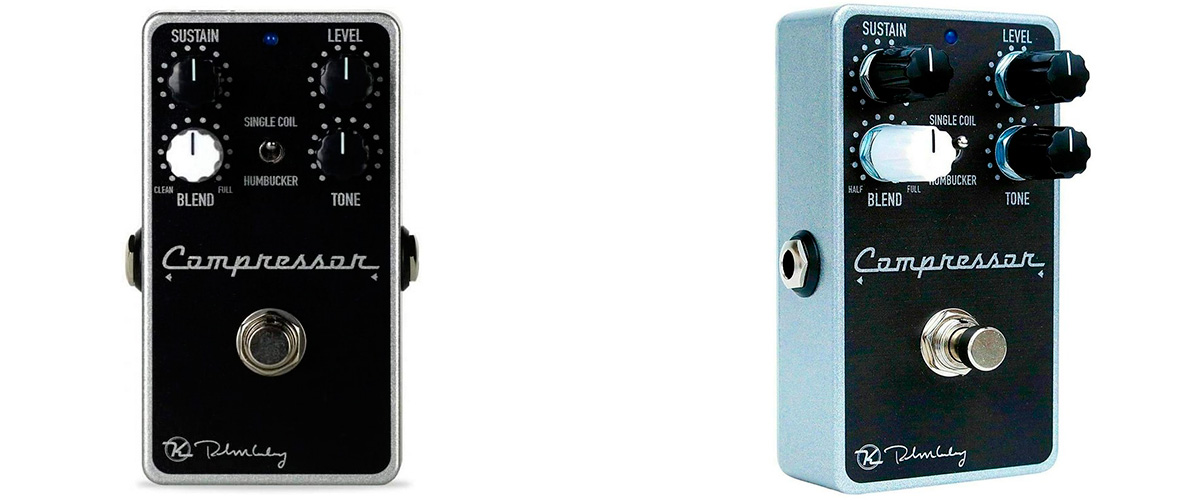
Keeley Compressor Plus is another compression pedal to enhance your guitar skills.
Being the product from the new line of Keeley compressors it helps you to dial it in easily to get the sound you want. It has 4 knobs, which stand for Blend, Sustain, Level, and Tone. The blend control adds your uncompressed guitar sound in, and this is most obvious on the initial attack on the note. After using it for some time I can assure you that even with half settings on level and tone controls you can get complete subtle compression. That also shows how music and user-friendly the design of the whole circuit is.
The sustain control here goes from barely perceptible to heavy compression but it ever feels or sounds mushy or unclear. The newly added expanded circuit definitely helps that by adding more gain as the notes fade out so you get a more even sustain in a more even feel.
The level control is more than the usual makeup gain. It really goes into boost territory.
The pedal also has a true bypass mode, which means that when the pedal is off, the instrument signal is routed directly to the amp without any of the mush, loading, or damping effects that usually occurs with the intermediary pedals.
With such a set of specs, you can be sure that this pedal will help you to rock on your electric guitar.
Pros
- Very versatile and transparent as for the mid-priced pedal
- The Sustain and Blend mode produce the sound exactly you pronounce it
- Broad EQ options with a tone knob
- Can be adjusted easily to single-coil guitar or humbuckers
Cons
- Sustain control adds distortion to the sound
- Brings much more power only when used with other compressors
BOSS BC-1X
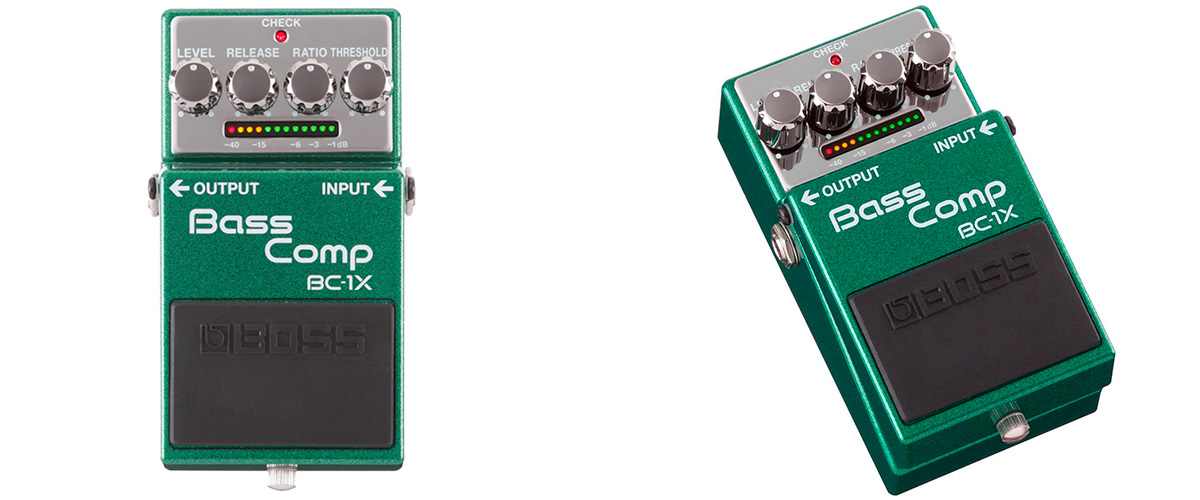
This one deserves to be among the smartest bass guitar compressor pedals. BOSS BC-1X is an intelligent multi-band compressor for expressive performers.
It incorporates state-of-the-art BOSS technology, far beyond the capabilities of traditional compressor pedals. This premium pedal effect provides intelligent circuit-controlled multi-band compression to preserve the natural sound of the bass in all musical styles. It has 4 built-in knobs for gaining the refined sound(Level, Release, Threshold, and Ratio), that will come in handy for experienced musicians. The well-thought-out circuit of the device is designed to work freely with a sound signal of different dynamics in any pitch registers to provide ideal compression in real-time without changing the timbre of the instrument. Your bass sound will never sound “muddy” or “jammed”! It provides a transparent and powerful sound and is extremely easy to operate. A nice supplement is that BOSS provides a five-year warranty on this product.
The BC-1X Multi-Band Compressor is a terrific tool for producing studio-quality, punchy sound for musicians who appreciate the expressive performance. In other words, it’s a professional compressor in a small unit. Feel free to buy it for your live shows and feel all the power of compression.
Pros
- It was esteemed by the professionals as the malleable and fully dynamic pedal
- Smart electronics help to automatically adapt to the sound of the bass guitar in any register and with any dynamic range
- The high-resolution gain meter provides visual control of compression depth
- 18-volt input allows you to connect any model of bass, providing clear and powerful sound
Cons
- The threshold will change the tone of your bass which can be undesirable
Best Bass Compressor Pedal Under $100
BOSS CS-3 – best budget
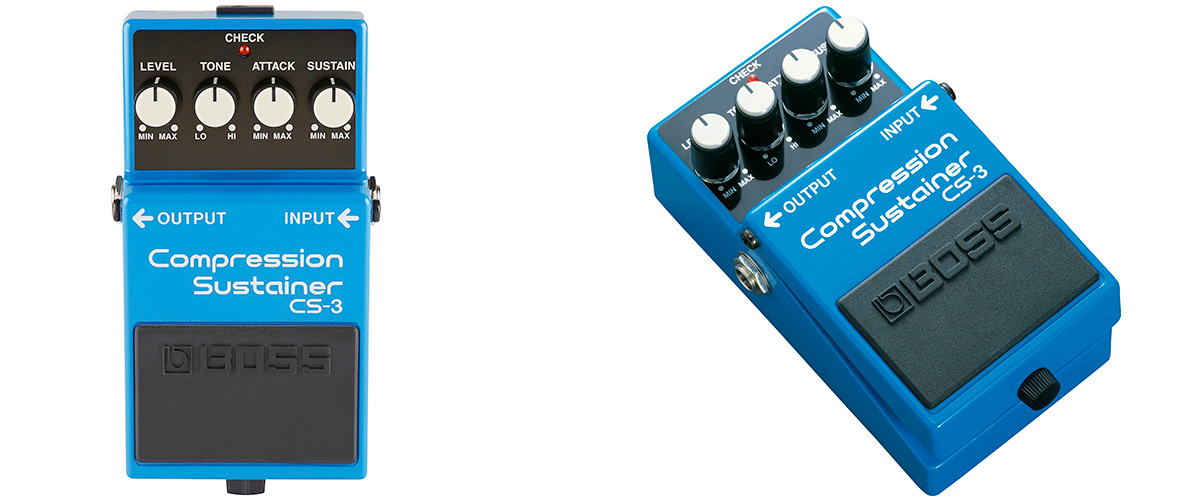
The BOSS CS-3 is an electric guitar stompbox that deserves to be called the best compressor pedal under 100 bucks. The compressor BOSS CS-3 is presented by a well-known Japanese manufacturer – BOSS. This model is known and loved by many musicians for its versatility.
Let’s take a look at the main features. The pedal is designed in a steel, compact body on a non-slip base. It correctly evens out the dips in the dynamics of the game, giving out smoother, more linear characteristics of the sound of electric or bass guitar. The complete set of knobs include Level, Attack, Tone, and Sustain that allows it to produce extremely low noise levels for quiet pedal operation. A passive electronic bypass is another advantage for clear instrument sound output. In general, this pedal will give you what can be called a soft and dynamic compression.
The dynamic compressor on the guitar pedal correctly evens out the sound of the guitar, while boosting weaker sounds and drowning out louder notes. The analog pedal compression evens out the overall volume of the instrument, further providing a tuned attack level. Analog sustainer adds the duration of the played note or chord, while significantly increasing the duration of the notes.
The BOSS CS-3 guitar pedal is designed with a robust steel body. The sole of the pedal has a rubber coating that prevents the pedal from sliding on the floor. The pedal controls are represented by the LEVEL knobs (controls the output signal level), TONE (controls and adjusts the tone), ATTACK (adjusts the compression level of the initial signal phase), and SUSTAIN (adjusts the audio signal compression level). The pedal can be powered in two ways. There is also a connector for a power adapter (AC Adapter Jack – DC 9 V).
Pros
- A sustainer is good for playing slow blues solos with a clean guitar sound or long, melodious overdrive solos
- Robust steel construction
- One pedal offers two devices: a dynamic analog compressor and a fully analog sustainer
- Long, soft sound with analog sustainer
Cons
- It’s not the true bypass as you need to adjust the distortion volume on high notes
- Not good for metal
Premium Bass Compressor Pedal
Darkglass Hyper Luminal – best premium
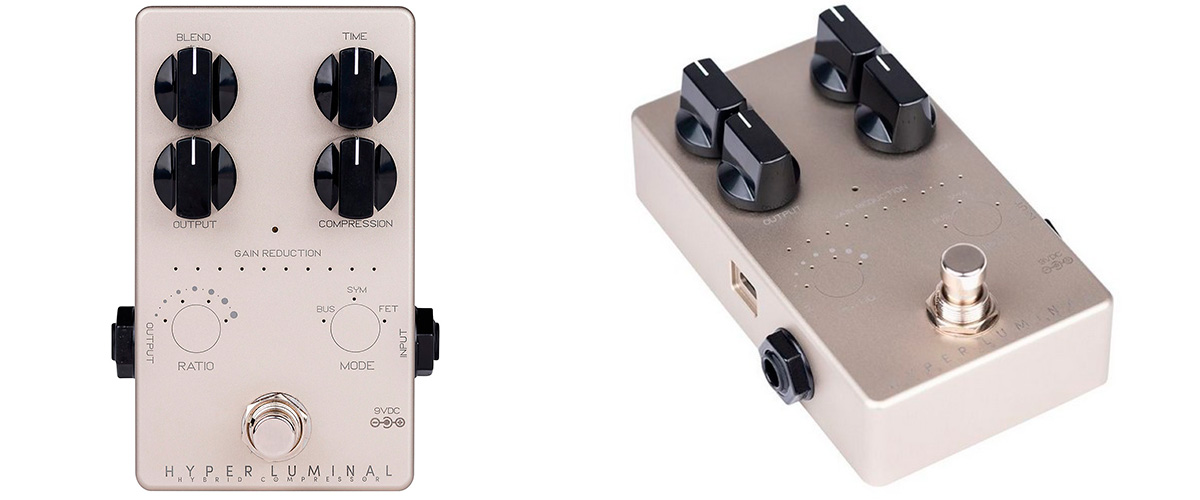
Darkglass Hyper Luminal Compressor is an innovative hybrid pedal-style compression design: VCA-based analog circuitry is digitally controlled by side-chain technology, allowing the sound of three legendary studio compressors to be delivered to the unit while still leaving the signal fully analog. From the first notes, I understood that it is one of the best compression pedals I’ve ever tried.
The Hyper Luminal replaced Darkglass’s successful SuperSymmetry compressor and immediately gained even more love in the bass community. What are the positive differences? The answer is simple: versatility and variety. The compressor has three modes of operation: the first is the sound of the same SuperSymmetry, and the next two reproduce two legendary studio compressors, namely the SSL Bus Compressor and the UAD 1176. Such a set can answer almost any request from a compressor bass pedal.
At the same time, the device remains incredibly easy to learn for everyone. It has all the classic compressor controls and a handy compression ratio meter. Add to that the impeccable sound and build quality from Darkglass. Finns, as always, surprise and assemble a top-class workhorse in an ergonomic form factor. And don’t forget that the sound remains completely analog!
The knobs on this pedal are a true gem. Blend control blends the compressed signal with the clean one, the output is in charge of the general volume control, time knob adjusts both Attack and Release parameters. Also, the compression knob is included – it adjusts the amount of compression and, in particular, the threshold. Then, Ratio – adjusts the intensity of the compression, and Mode – switches between compression modes.
Pros
- It features all possible compressor modes, including All-Button or British mode that makes all the 4 LEDs light up simultaneously
- Brings the high-definition bass
- Has the USB interface
- Versatile product that definitely suits the professional purposes
Cons
- The power jack looks not appealing at all
- There’s no switch to interchange custom loadouts
Origin Effects Cali76
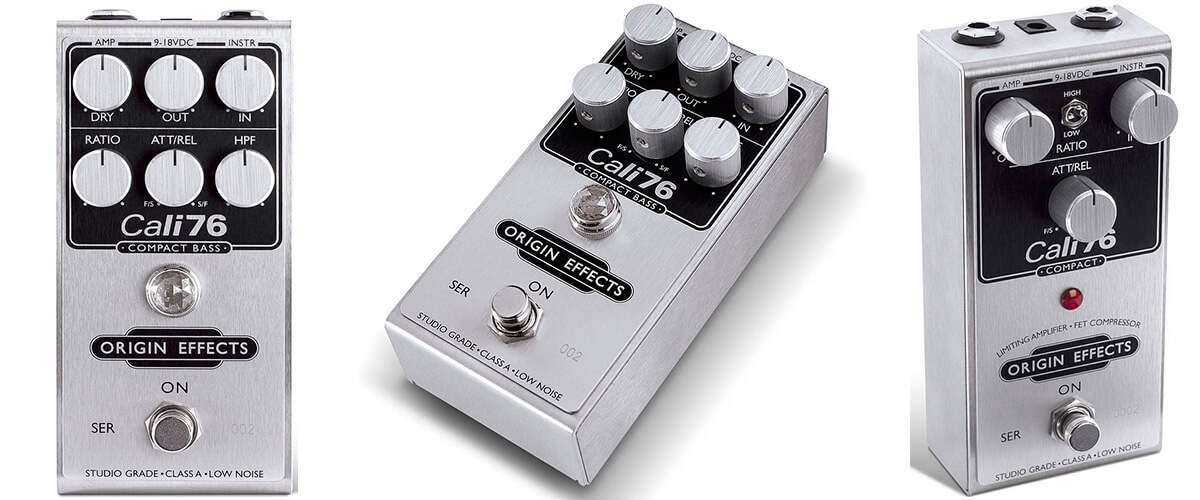
I want to tell you about this amazing 1176-style studio-grade FET compressor that comes with high-current, low-noise, and discrete Class-A circuitry. On top of that, it has a dedicated parallel compression control.
The manufacturer added the much-requested parallel mix control, which before could only be found on its limited editions. Unlike many other guitar compressors, the Cali76 has extraordinary flexibility in its settings: separate controls for Attack, Release, and Ratio give the full control over the compression of the signal and let you get exactly the dynamics you need.
A distinctive feature of the Cali76 bass compressor pedal is the Dry control, which allows you to combine heavily compressed and uncompressed signals to get great compression effects without losing natural dynamics. What you get is called an effect of parallel compression. Until now, such features have been used mainly only in studios, but now it is possible to transfer it to live play on stage. Since the device comes in a sturdy metal case, it will not be a problem to carry it everywhere.
The Cali76 features a very nice studio-grade input preamplifier. In addition, it is equipped with an unbalanced instrument output and balanced line output. This model can run at nine volts; however, 18 is recommended for increased headroom, cleaner processing, and also for handling higher signal levels (e.g., active pickups).
Pros
- Enhances subtle details and clarity of guitar audio
- The single knob works very well, allowing you to smoothly traverse the range between a fast attack and slow release
- By combining your “honest” guitar audio with more subtle compression, you have the possibility to get three-dimensional sparkling audio, which you can usually hear on records not out of an amp
Cons
- The compressor takes out high-end frequencies
Buyers Guide
Bass Compressor Settings
In this guide, I will help you to learn the functions of different knobs on the compressor pedals and choose the best bass compressor pedal.
First, we have an input knob. It’s in charge of the signal level into the pedal’s circuit, which can affect the response of the compressor itself too. The farther you push gain on it the faster it will hit the threshold
The threshold sets the signal level at which the compressor starts. The higher the value (clockwise), the louder you have to play for the compressor to work. The lower the value (counterclockwise), the earlier the compression will take effect, and you will hear the effect even if you play very quietly.
The ratio knob usually represents a range between 1:1 and infinity, depending on the category. It shows how much signal difference there is after its level goes beyond the threshold. For example, a 2:1 ratio means that above the threshold, each 2dB increase in volume will deliver a 1dB change in signal output.
Attack and Release controls are used when you exceed the set threshold. In such a case the compressor gets a pause, but with the Attack control, it is possible to delay the start of compression. On the opposite, Release defines the amount of time it takes for the compressor to return to normal after the signal has dropped below the threshold.
The Blend is a very useful mode for the resulting sound. On some models, it allows you to mix the effect your compressor is producing (wet) with your original signal (dry) at the same time. It’s not considered absolutely necessary but will be a great plus for professional studio work.
A True Bypass is an essential option which can be used whether or not your signal is being manipulated when the bass compressor is switched off. Beware – it’s better to have your signal go through without any change.
Finally, the Make-up or Output Level control. It determines the way the compressor responds to your playing. In the extreme right position, the compressor acts as a peak-limiter, doing a simple “brick wall” attenuation (lowering the signal level) when your signal reaches the threshold. The gain knob is needed because when you compress the signal it becomes quieter, and the Output control allows you to compensate for volume losses. By the way, “Gain” is just a more accurate, scientific name for “volume” or “level”. So, there is nothing mysterious about this regulator.

